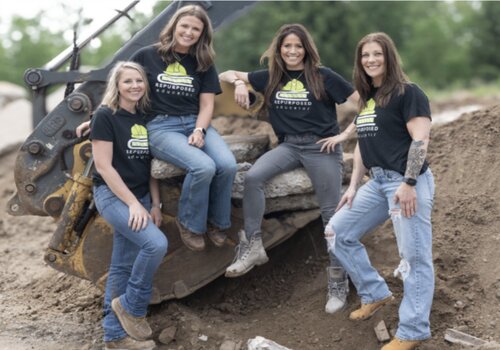Failure to Call 811 Remains Top Reason for Underground Utility Strikes
April is National Poetry Month and National Safe Digging Month, so here’s a haiku about the importance of calling 811 before beginning any excavation project:
Call before you dig,
Or risk injuring workers,
and financial loss
Those words may not rhyme, but they’re smart advice that every construction professional should remember, according to the Common Ground Alliance, a nonprofit group of damage-prevention professionals in the underground utility industry.
ANNUAL DAMAGE INFORMATION REPORTING TOOL REPORT DATA
Last October, the CGA published its annual Damage Information Reporting Tool report, which found that in 2023, there were 180,471 cases of damage to buried utility infrastructure in the United States. What’s more, failure to notify a local 811 center by phone or online was cited as a root cause in 26.2% of those incidents, more than any other factor.
Other contributing factors included the excavator failing to maintain clearance after verifying utility marks (15.1%), the facility not being marked due to locator error (14.4%), an improper excavation practice not listed elsewhere in the survey (8.2%), inaccurate markings due to locator error (7.2%) and the excavator digging prior to verifying marks by potholing (4.61%), according to the DIRT report.
Natural-gas and telecommunication lines were the most frequently damaged, with water/sewer and telecom work the top drivers of that damage. Contractors were involved in 83% of natural-gas damages and 92% of telecom damages in the United States last year, according to the DIRT report.
STARTING AN 811 TICKET
In an online video aimed at contractors, the CGA acknowledges that digging projects have many moving parts, including permits to obtain, equipment to coordinate and crews to manage, all on an unforgiving schedule. That makes it understandable for contractors to become frustrated when an 811 locate request is delayed, the group says.
One key finding from the DIRT report: In 2023, excavators faced 50/50 odds of being able to begin work on time due to late 811 location data.
“This hampers efficiency, erodes trust in the entire 811 system and puts lives at risk,” said Sarah K. Magruder Lyle, president and chief executive of the CGA. “Addressing this challenge head-on must be a priority for every stakeholder in the coming year.”
Excavators can’t solve this problem themselves, but they can follow some best practices to streamline the 811 process, according to the CGA. First, contractors should provide accurate and detailed information when starting an 811 ticket. Be as specific as possible about the dig site, and only request marks where the proposed excavation work is taking place.
Whenever possible, provide GPS coordinates to improve accuracy, white-line the proposed site and include information about relevant landmarks. That information helps to narrow down the scope of work so locators can focus on marking what’s really needed for each project and avoid spending time on unnecessary marks, the CGA said.
Excavators should provide accurate contact information for someone onsite or familiar with the dig site and schedule. They also should provide an accurate description of the work to be performed, which helps locators to address internal concerns in advance and arrive better prepared, according to the CGA.
MONITORING QUALITY
In addition to improving the quality of their 811 tickets, contractors should monitor the quantity of their requests, the CGA said. Excavators should request utility locates with sufficient notice to be marked, but they shouldn’t request marks for work that they can’t reasonably expect to begin within the life of the ticket.
Submitting too many tickets at once puts a strain on the system and prevents locators from getting to the most time-sensitive sites promptly, the CGA says in its video. Therefore, contractors should avoid requesting “backup sites” to be marked or creating “just in case” tickets.
Active tickets should match the actual schedule of the work being performed and follow the requirements of state digging laws. Contractors should avoid submitting duplicate requests and remarks on jobs that have been completed, the CGA said. Often, locate requests are updated or refreshed long after work has been completed, causing locators to waste time marking inactive jobsites instead of active ones.
NATIONAL SAFE DIGGING MONTH
National Safe Digging Month serves as a reminder that digging without locating utility lines results in injuries, loss of life and property damage every year, according to the Pipeline and Hazardous Materials Safety Administration.
That agency, part of the U.S. Department of Transportation, notes that damage from digging also can lead to utility outages and fines, which is why every dig requires a call or online visit to an 811 center. Dialing 811 automatically routes callers to their local center.
Once they’ve submitted a request, contractors receive a ticket number, a deadline for utilities to respond to the request and instructions to confirm that all utilities have responded before digging begins. State laws vary, but utility companies typically have several days to respond to requests, and on average, seven to eight utility operators are notified of each request, the CGA said.
REMEMBER WHILE DIGGING
The CGA emphasizes that even small projects, such as planting a garden or installing a mailbox, require a call to 811 since some utility lines may be buried at shallow depths. When digging, be sure to carefully dig around the marks, not on them, and remember that erosion or root-structure growth may shift the location of utility lines over time, so it’s important to call each time you’re planning to dig.
State laws generally prohibit the use of mechanized equipment within 18 to 24 inches of a marked utility, the so-called “tolerance zone,” which may vary from state to state, according to the CGA. If you must dig near the marks, hand dig or use vacuum excavation to expose the utility. Then, continue to avoid using mechanized equipment within the tolerance zone.
If contractors see clear evidence of a utility, such as an above-ground marker, manhole cover or utility box, but no utility marks, they should contact their 811 centers so the utility can be notified.
April may be National Safe Digging Month, but it’s also National Stress Awareness Month, and by following best practices on digging projects, contractors can eliminate some stress and risk from their operations.
Photo credit: BANNAFARSAI/BIGSTOCKPHOTO.COM












